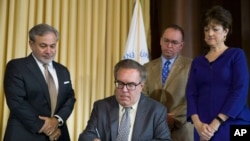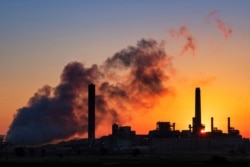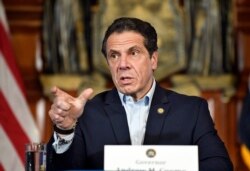The split on climate change between the federal government and the states widened this week.
The Trump administration issued a rule on greenhouse gas emissions from power plants Wednesday that critics say will do little more than what the industry is already doing -- and far less than what many scientists say is essential to do.
Meanwhile, New York passed an aggressive law Thursday to rid its economy of planet-warming carbon emissions by the middle of the century, the latest in a string of states increasing action to combat climate change.
With lethal heat waves, wildfires and severe storms on the rise, scientists warn that emissions need to decline sharply as soon as possible to avoid potentially catastrophic levels of planetary warming.
ACE in the hole
The Trump administration's new Affordable Clean Energy rule allows states to set efficiency targets for coal-fired power plants and offers a menu of options to achieve them.
By 2030, power plants will reduce emissions by 35% from 2005 levels under ACE, according to the Trump administration.
Emissions in the electricity sector have already declined 28 percent thanks to the rise of cleaner natural gas and, more recently, renewable energy.
"We owe much of this progress to the genius of the private sector and the free markets, not the heavy hand of government," said Environmental Protection Agency Administrator Andrew Wheeler at a signing ceremony Wednesday.
But some scientists say much deeper cuts are necessary. Total carbon dioxide emissions need to be cut nearly in half by 2030 in order to stave off the worst effects of climate change, they warn.
Environmental groups blasted the new rule and promised to fight it in court.
"It is dangerously irresponsible and completely at odds with the urgent need to address climate change, not to mention the EPA's mission to protect public health," said Ken Kimmell, president of the Union of Concerned Scientists.
States take over
ACE replaces the Obama administration's Clean Power Plan, which set much stricter limits on greenhouse gas emissions but was tied up in court before it was implemented.
While the federal government is backing away from acting on climate change, some states are taking tougher steps to address it.
Just hours after Wheeler signed the rule weakening emissions rules, the New York state legislature passed the nation's strongest restrictions on greenhouse gases.
The Climate Leadership and Communities Protection Act requires the state to eliminate or offset carbon emissions entirely by 2050.
Democratic Gov. Andrew Cuomo of New York is expected to sign the measure.
"For the future of humanity and our planet, we need to move off of fossil fuels towards a renewable economy, and we hope the commitment we won for New York encourages other states to follow our lead," said a statement from NY Renews, a coalition of more than 180 environmental, justice, faith, labor, and community groups.
New York's action follows California, Washington and New Mexico, which have passed laws requiring 100% clean electricity by mid-century. Maine is poised to take similar action. New York's law goes farther, though, covering the entire economy, from electricity to transportation to agriculture.
Other states also have stepped up their actions. Nevada now requires 50% clean energy by 2030. New Jersey is set to rejoin a group of states that charge polluters for carbon dioxide emissions. Virginia and Pennsylvania also are considering joining.
WATCH: US States Tackle Emissions
Driving the split
The split between state and federal governments is likely to deepen.
California currently has legal authority to set stricter rules for vehicle efficiency and carbon dioxide emissions than the federal government. Twelve states and the District of Columbia follow California's standards. However, the EPA is working to relax those standards and has clashed with California over its special status.
Negotiations have broken down, with both sides blaming the other. In a letter to Republican lawmakers Thursday, EPA Administrator Wheeler accused California Air Resources Board Chair Mary Nichols of negotiating in bad faith and harboring "conspiracy theories" about EPA's motivations for the rollback.
Nichols strongly disagreed, saying that "the Trump administration has been unwilling to find a way that works."
Transportation is now the leading source of greenhouse gas emissions in the United States, and a growing source around the world.


